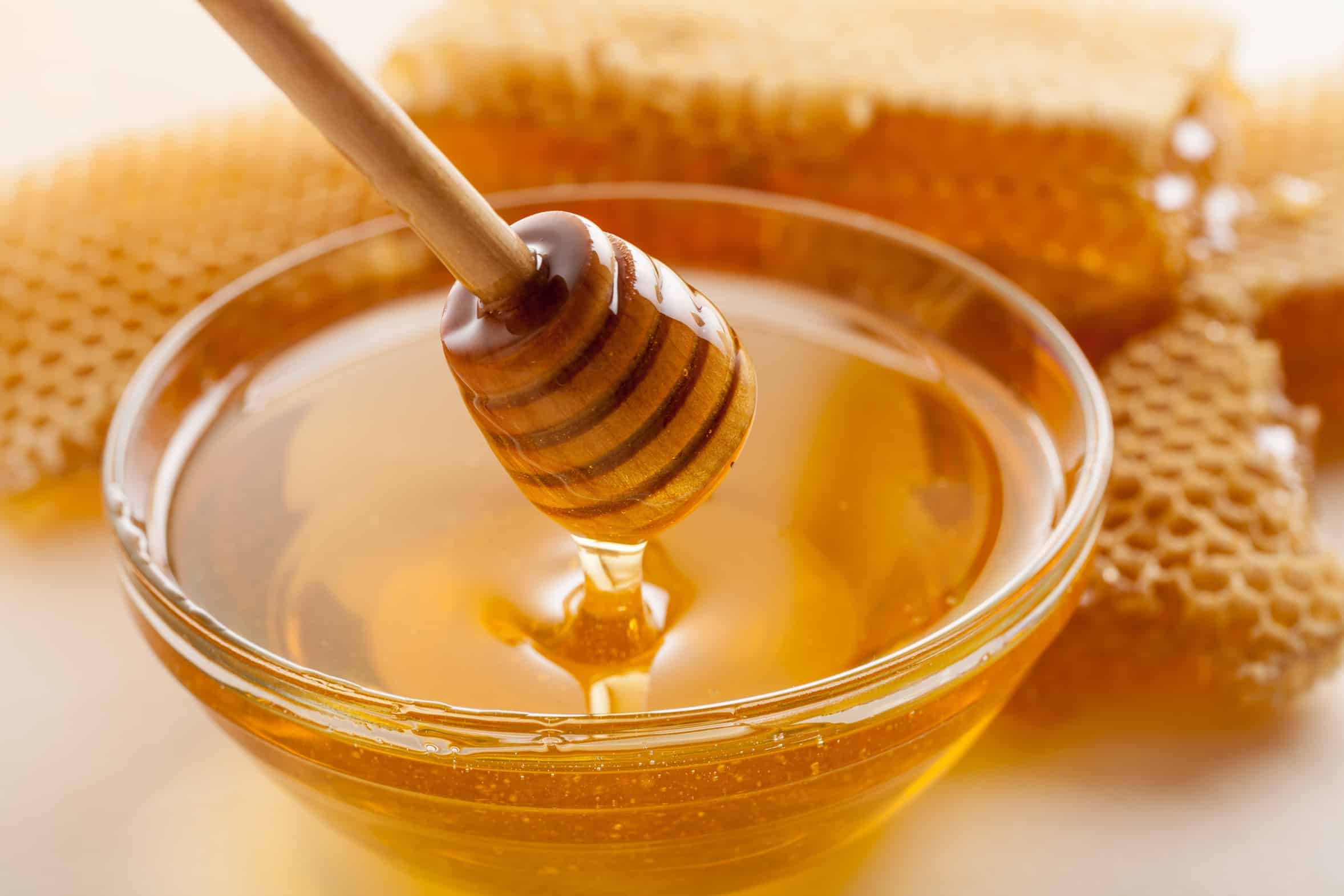Honey

Honey (INCI name = Mel) is the bee product that comes to mind ad hoc when we talk about bees. Honey is beloved as a food as well as a stimulant. It is one of the few luxury foods with indisputable health benefits and one of the most complex natural products at all. But also, in the cosmetics industry Mel finds its application, due to its health-promoting characteristics.
What is Mel made of?
Mel is a viscous to solid (partially crystallized) substance that tastes very sweet due to its high content of fructose and glucose. In addition to these and other sugars (a total of 70% glucose + fructose and 10% sucrose + maltose), Mel contains 15 to 21% water (heather honey can contain up to 23% water) as well as enzymes, vitamins, amino acids, pollen, aromatic substances, and minerals. The Mel varies in its composition, because the weather and also the regional nature of the floral world is very different. This also applies to its color and taste – both are characteristics of the most diverse types of honey.
Due to this composition, Mel is generally considered healthier than household sugar (sucrose) for human use.
According to the EU regulation and German honey regulation, nothing may be added to honey and nothing may be taken away from it. Thus, the honey is 100% natural.
Sugar
Sugar is the main ingredient of Mel. Sugar, from the Arabic sukkar (verb: sakkara), is food and stimulant at the same time. The chemical term sugar is a collective term that covers a whole class of different substances. The following is a brief outline of the most important sugars found in Mel.
Fructose
As a monosaccharide (simple sugar), fructose (from Latin fructus, meaning “fruit”), often also fructose (obsoletely called levulose), belongs to the carbohydrates. Fructose occurs in nature mainly in fruits and in Mel. Fructose is optically active (stereoisomer) and belongs to the hexoses, there because of the keto group to the ketoses. It has the molecular formula C6H12O6. In crystalline form it exists as fructopyranose, bound as fructofuranose.
Sucrose
Sucrose, also known as table sugar, is the household or granulated sugar commonly considered “the sugar.” Like other sugars, sucrose belongs to the carbohydrates. It is a disaccharide (two-sugar). As a dimer, sucrose consists of one molecule each of alpha-D-glucose and beta-D-fructose. These two molecules are linked by an a,b-1,2-glycosidic bond.
Glucose
Glucose, also called D-glucose or dextrose, is a simple sugar (monosaccharide).
The molecular formula of glucose is C6H12O6. Dextrose is the most important energy supplier in the human organism. The red blood cells and the kidney marrow are even completely dependent on glucose for energy, the brain partly. In starvation metabolism, the brain can obtain up to 80% of its energy from ketone bodies. The glucose content of the blood is about 0.1% and is regulated by the hormones insulin and glucagon.
Glucose can be completely broken down in the body to water and carbon dioxide via glycolysis, oxidative decarboxylation, the citrate cycle, and the respiratory chain. However, when glucose is in high supply, the metabolite acetyl-CoA can also be used for fatty acid synthesis. Glucose also replenishes the body’s glycogen stores, which are found primarily in the liver and skeletal muscles.
Maltose
Maltose is the Latin technical term for malt sugar. It is a twofold sugar: two alpha-D-glucose molecules are linked together acetally via a glycosidic and an alcoholic OH group with H2O splitting off (1,4-alpha-glycosidic bond). In isomaltose, on the other hand, the linkage of the two glucose molecules occurs between the C1 and C6 atoms.
Melezitose (honeydew)
Melezitose is a special type of sugar that is contained, for example, in melt dew, a sugar-containing excretory product of various beaked insects (Hemiptera), such as aphids (Aphidina). It is formed by these insects from sucrose and glucose to improve their own water balance (less water removal by osmosis) and to attract ants as protectors. Melezitose, like other sugars, belongs to the carbohydrates and is a triple sugar consisting of the linkage of two molecules of glucose and one molecule of fructose. Hydrolysis under mild conditions produces glucose and turanose (an isomer of sucrose). In beekeeping, forest honey produced from honeydew occasionally has the effect that, in addition to the main components of fructose and glucose, a proportion of more than 10 to 12% of melezitose is present. This then leads to the fact that the Mel crystallizes fast, mostly already in the Melraum of the bee colony (from the soil of the honeycomb cell), so that it can be harvested no more, or only partially, with clearly increased expenditure. This Mel is then called melezitose honey or cement honey.
Honey almost eternally durable
Due to its high sugar and low water content, Mel has a long shelf life, although it can crystallize. The ratio of fructose to glucose (the two main components) is responsible for the tendency to crystallize. If both types of sugar are present in approximately equal proportions, as in the case of rape honey, for example, crystallization occurs within a few days. In honeydew types, e.g. fir honey, the ratio is about 1.6 : 1. This Mel remains liquid for months or even years.
Mel that has become solid and crystallized can be liquefied again by gentle heating; however, temperatures above 40 °C destroy important constituents (enzymes). The high sugar content and low water content prevent bacteria and other microorganisms (e.g., yeasts) from multiplying; they are osmotically decomposed.
Mel in cosmetics
Honey is a bee product with high nutritional value and regenerative properties, which is why it is used in skin care products. Honey has an antimicrobial effect due to the enzymes it contains, glucose oxidase and lysozyme. Glucose oxidase is partly responsible for the antibacterial property and the enzyme lysozyme for the antifungal effect. As a result, honey can be used in the treatment of wounds, dandruff, and psoriasis. Furthermore, the high content of flavonoids and phenolic acids provides the antioxidant property of honey and thus protects the skin from free radicals. Honey also soothes skin irritations and moisturizes, so chapped lips, dry hair and rough hands can benefit from honey-based additives.
Mel is often used in cosmetics as a concept ingredient, for example in combination with milk. Due to the contained enzymes, trace elements and antibacterial acting ingredients Mel has a beneficial effect on the skin condition. It protects and nourishes the skin and hair. There are now also some extracts or active ingredients based on Mel. These active ingredients then have very specific functional effects on skin or hair.
Manuka honey in particular is said to have a beneficial effect, as it has a higher content of methylglyoxal compared to other types of honey. The high content of methylglyoxal provides for its strong antibacterial effect.
But also, the wax from the extracted honeycombs and the bee venom are valuable ingredients in cosmetics. Read more exciting facts about the topic “Apitoxin“.
Fact Sheet – Honey
INCI: Mel
CAS Number: 8028-66-8
Properties: moisturizing, antimicrobial and antioxidant
Disadvantages: allergic reaction (very rare), possible hypersensitivity reactions, animal origin.
See here the honey-based raw materials with which we like to work:
| Trade Name | Company Name | INCI | Comment |
|---|---|---|---|
| Crodarom Honey | Crodarom | Aqua, Glycerin, Honey Extract | |
| Biothex Honey | Shanghai JAKA(GREAF) Biotech Co., Ltd. | Water, Butylene Glycol, Mel | |
| SCB Manuka Honey | Lucas Meyer Cosmetics | Glycerin, Water, Honey Extract | |
| Fermented Honey PG | IWASE COSFA EUROPE | Gluconobacter/Honey Ferment Filtrate, Propylene Glycol | |
| Blossom Honey Pro | Lipoid Kosmetik AG | Glycerin, Aqua, Mel Extract | |
| Honey Oily Extract - BCE1119 | Biocosmethic | Helianthus Annuus (Sunflower) Seed Oil, Mel Extract | |
| HONEY - GLYCERINATED EXTRACT (GR) | AQiA Química Inovativa | Honey Extract | |
| Melhydran LS 9876 | BASF | Aqua, Butylene Glycol, Honey Extract, Glycerin, Urea | |
| Acacia Apissence | Provital | Glycerin, Propanediol, Water, Honey Extract | |
| Glycoderm (P) | CLR Chemisches Laboratorium Dr. Kurt Richter GmbH | Aqua, Honey, Phospholipids, Sphingolipids, Hyaluronic Acid | |
| Bio Apis | AQiA Química Inovativa | Honey Extract, Propolis Extract, Pollen Extract, Royal Jelly Extract | |
| Black BeeOme | Mibelle AG Biochemistry | Honey, Zymomonas Ferment Extract, Alcohol, Water (Aqua) | |
| Apibreeze | Provital | Water, Glycerin, Gluconolactone, Honey, Lactobionic Acid | |
| PANTROFINA NMF | Sharon Laboratories Ltd | Aqua, Sodium PCA, Mel, Urea, Fructose, Glucose, Pentylene Glycol, Citric Acid, Glycine, Acetyl Glucosamine, Glucuronolactone, Lysine HCl, Propylene Glycol, Hydrolyzed Collagen, 1,2-Hexanediol, Caprylyl Glycol, Tropolone | |
| Akoactive Romae GL | Akott Evolution | Glycerin, Aqua, Mel, Iris Florentina Root Extract, Myrtus Communis Extract, Laurus Nobilis Leaf Extract | |
| Akoactive Romae BG | Akott Evolution | Butylene Glycol, Aqua, Mel, Iris Florentina Root Extract, Myrtus Communis Extract, Laurus Nobilis Leaf Extract | |
| Extracto Hidroglicólico De Miel | Neyber SAS | Mel Extract |
Honey – a highly effective natural substance
Sugar-sweet beauty miracle: Honey has a long tradition as a natural remedy. Many of its effects have been scientifically confirmed and are used in medicine, naturopathy, and cosmetics. The Mel finds its application in shampoos and hair masks, in creams, lotions, solid soaps and lip balms. Due to its anti-inflammatory, protective and moisturizing properties it is a great ingredient in cosmetics. Are you interested in high-quality cosmetic formulations with honey-based raw materials? We at Cosmacon will be happy to help you.
Quellen:
Bee Products in Dermatology and Skin Care.; Molecules. 2020 Jan 28;25(3):556.
Therapeutic Properties of Bioactive Compounds from Different Honeybee Products.; Front Pharmacol. 2017 Jun 28;8:412.
Hydration and Barrier Potential of Cosmetic Matrices with Bee Products.; Molecules. 2020 May 28;25(11):2510
Chemical Extraction and Gastrointestinal Digestion of Honey: Influence on Its Antioxidant, Antimicrobial and Anti-Inflammatory Activities.; Foods. 2021 Jun 18;10(6):1412
